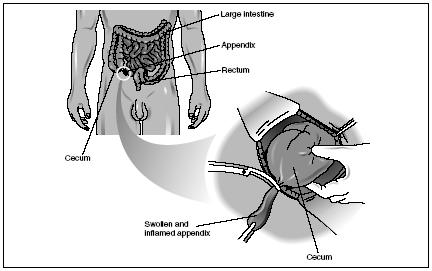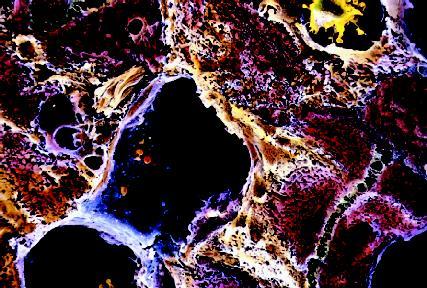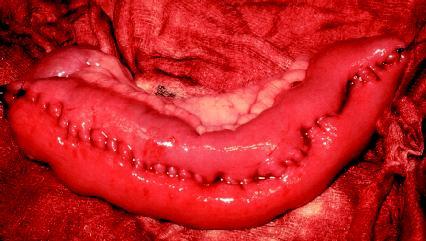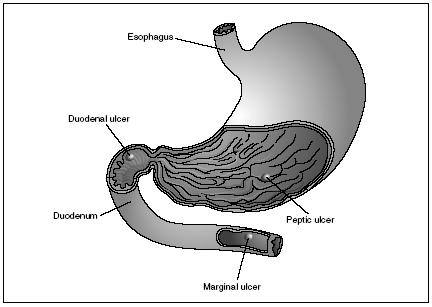The Digestive System - Ailments: what can go wrong with the digestive system
Many ailments or maladies can afflict the digestive system. Although it is remarkably resistant to abuse, it is still vulnerable and can break down. Some ailments are relatively minor, such as canker sores in the mouth. Others are severe and life-threatening, such as cancers that can target almost every part of the digestive system.
As an individual ages, the activity of the digestive system slows down. Fewer digestive juices are produced and secreted. Peristalsis slows. The sensations of taste and smell wane, and eating becomes less appealing. When less food is ingested, the body receives fewer nutrients. All body systems then weaken and become susceptible to disease.
The following are just a few of the legion of ailments that can beset the many parts of the digestive system.
Appendicitis
Appendicitis is an inflammation of the appendix. It is the most common abdominal emergency found in children and young adults. Because of the appendix's position at the bottom of the cecum, scientists believe one of the main causes of appendicitis is an invasion of bacteria. When infected with bacteria, the appendix may become swollen and filled with pus. It may then eventually rupture. Symptoms of the condition include pain that begins above or around the navel. The pain, which may be severe or only achy, then moves into the right corner of the abdomen. In this position, the pain often becomes more steady and severe. If left untreated, appendicitis is fatal. The treatment for the condition is an immediate appendectomy or surgical removal of the inflamed and ruptured appendix.
Biliary atresia
Biliary atresia is a condition in which ducts to transport bile from the liver to the duodenum fail to develop in a fetus. The condition is the most common fatal liver disease in children. Half of all liver transplants are done for this reason. Scientists have yet to find a convincing cause for this birth defect.
In a child with this condition, bile begins to back up into the liver and eventually into the rest of the body. The child becomes jaundiced (skin turns yellow). The abdomen then begins to swell and the child becomes progressively more ill. If left untreated, liver failure and death will occur within two years.
Surgery is the only treatment for biliary atresia. The surgeon must find a way to create an adequate duct or pathway for the bile to drain from the liver into the intestine. Even if the surgery is successful, persistent disease in the liver will gradually destroy the organ. A liver transplant currently offers the best hope for this condition.

Cavities
A dental cavity or tooth decay is the destruction of the enamel or outer surface of a tooth. It is a common health problem, second only to the common cold. It results from the action of bacteria that live in plaque. Plaque is a sticky, whitish film that forms on teeth, composed of a protein in saliva, sugars from foods, and bacteria. The bacteria use the sugars and starches from food particles in the mouth to produce acid that dissolves tooth enamel, creating cavities or holes. If the decay reaches the dentin, the tooth becomes sensitive to temperature and touch. If the decay reaches the pulp cavity, inflammation and pain (toothache) develop.
If left untreated, the decay can eventually destroy the entire tooth. Usually, a dentist is able to treat most cases of tooth decay by removing all decayed parts of the tooth and then filling the cavity with a hard material. If the decay has attacked the pulp, the dentist may perform a root canal treatment, removing the pulp and filling the inside chamber. If a majority of a tooth has to be removed, the dentist covers the tooth with a crown.
Cirrhosis
Cirrhosis is a chronic (long-term) disease in which cells of the liver are damaged and then replaced by scar tissue. The disease obviously affects the liver's ability to perform its many functions. The condition worsens over time and may lead to death. Twice as common in men as in women, cirrhosis is the seventh leading cause of disease-related death in the United States.
Long-term alcoholism is the primary cause of cirrhosis in the United States. Throughout the digestive system, alcohol interferes with the absorption of nutrients. Alcohol provides calories but no nourishment to the body. It also robs the body of vitamins and minerals necessary to maintain proper cell function. Because alcohol is detoxified within the liver, a constant level of alcohol in the organ severely affects it. Cirrhosis may also be brought about by viral infections like hepatitis B and hepatitis C (see page 56).
During the early stages of cirrhosis, the liver enlarges. The palms of the hands then turn red. Other symptoms include constipation or diarrhea, dull abdominal pain, fatigue, loss of appetite, nausea, vomiting, weakness, and weight loss. If left untreated, the symptoms increase and worsen, leading to liver failure and death.
The primary treatment for cirrhosis is to reduce the condition causing it. A person suffering from cirrhosis must not consume alcohol. A balanced diet, which helps regenerate healthy liver cells, must be followed. In patients with advanced cirrhosis, a liver transplant may be necessary.
Diverticulosis and diverticulitis
Diverticulosis is a condition in which the inner layer of the large intestine bulges out through the outer, muscular layer. These bulges are called diverticula. When they become infected and inflamed, the resulting condition is known as diverticulitis.

Diverticula occur most frequently in individuals whose diets are low in fiber. Since the amount of fecal matter produced is low, the large intestine must narrow itself and contract forcefully to move the smaller feces along to the rectum. Over time, this weakens the muscular wall, allowing diverticula to develop.
Diverticulitis occurs when a hardened piece of stool, undigested food or bacteria becomes lodged in the diverticula. Blood supply to the area is disrupted and infection sets in. Symptoms of diverticulitis include pain in the lower left side of the abdomen and fever. Abscesses (walled-off pockets of infection) may develop within the wall of the intestine.
Diverticulitis is quite treatable. Usually, the intestine is "rested" by preventing the individual from eating or drinking anything by mouth. Medications to fight the infection are also given. Once the condition is brought under control, the individual must adhere to a high-fiber diet.
Anorexia nervosa is an eating disorder that usually occurs in young women. Anorexia comes from the Greek word anorektos , meaning "without appetite." The problem for anorectics (individuals with anorexia) is not that they lack an appetite. The problem is self-image. Anorectics do not eat because they fear gaining weight. They see themselves as "fat" even if they are severely underweight.
Some anorectics refuse to eat at all; others eat only small portions of fruit or vegetables. A few live only on diet drinks. In addition to fasting, anorectics may exercise strenuously to keep their weight low.
The body is severely affected. Skin becomes dry and flaky. Muscles begin to waste away. Bones stop growing and become brittle. The heart weakens. Because the body has almost no fat to keep it warm, downy hair grows on the face, back, and arms. The heart weakens. Muscle cramps, dizziness, tiredness, and even brain damage and kidney and heart failure may occur. An estimated 10 to 20 percent of anorectics die, either from starvation or by committing suicide.
Medical researchers believe anorexia is caused by a combination of biological, psychological, and social factors. Low self-esteem, fear of losing control, and fear of growing up are common characteristics of anorectics. The emphasis on thinness in American culture is believed to contribute to the disorder.
Hospitalization, combined with psychotherapy and family counseling, is often needed to control anorexia. About 70 percent of anorectics who are treated for about six months return to normal body weight.
If the condition is severe and surgery is needed to remove a portion of the intestine filled with abscesses, a colostomy is performed. This involves pulling the end of remaining intestine through the abdominal wall and attaching it to a bag on the outside. Because the intestine no longer connects with the rectum, the individual's feces pass out of the intestine into the bag. The colostomy may be temporary (until healing has occurred) or it may be permanent.
Gallstones
Gallstones are solid crystal deposits that form in the gall bladder. They can vary in size from as small as a grain of sand to as large as a golf ball. Eighty percent of all gallstones are composed of cholesterol, a fatlike substance produced by the liver. Gallstones form when the liver produces more cholesterol than intestinal juices can liquefy.
Gallstones are the fifth most common reason adults are hospitalized in the United States. They usually develop in adults between the ages of twenty and fifty. The condition of developing gallstones tends to run in families. In addition, high levels of estrogen (female hormones), insulin (hormone that regulates sugar levels), and cholesterol in the body increase the risk of developing gallstones. A diet high in fat and low in fiber, heavy drinking, and smoking may also play a part.
Gallstones may block the common bile duct, preventing bile from flowing into the duodenum. A gallstone in the cystic duct may cause the gall bladder to become inflamed. Symptoms of a gallbladder attack include pain that begins in the abdomen and moves to the chest and back, chills and sweating, nausea and vomiting, and gas and belching.
Bulimia is an eating disorder that occurs chiefly in women in their teens and twenties. Bulimia comes from the Greek word boulimos , meaning "great hunger." Individuals who are bulimic go on eating binges (often gorging on junk food), then purge their bodies of the food by making themselves vomit or by taking large amounts of laxatives (medicines or foods that stimulate bowel movements).
During an eating binge, bulimics favor high-carbohydrate foods: candy, donuts, cookies, cakes, cereal, bread, soft drinks, and ice cream. At one sitting, bulimics consume more calories than they normally would in an entire day. They usually eat quickly and messily during a binge, stuffing the food in their mouths and gulping it down.
The self-induced vomiting after a binge can cause damage to the stomach and esophagus. Acid in the vomit from the stomach can irritate the throat and erode tooth enamel. Blood vessels in the eyes can burst. The overuse of laxatives can cause muscle cramps, stomach pains, dehydration, and even poisoning. Over time, bulimia causes vitamin deficiencies and an imbalance of critical body fluids. Seizures and kidney failure can ultimately result.
Bulimics know that their eating habits are abnormal. They often suffer from depression, especially after a binge. Bulimics may also suffer from anxiety and low self-esteem. Some medical researchers believe bulimia is related to an imbalance in the brain chemical serotonin, which influences mood. Most research on bulimia, however, focuses on psychological factors. Treatment for bulimia generally involves psychotherapy and, sometimes, the use of antidepressant medications.
Gallstones of a small size may pass out of the body through the urine. So they may more easily pass out, doctors may use high-frequency sound waves to break up the gallstones. To treat painful, severe cases, doctors may surgically remove the gall bladder and gallstones.
Heartburn
Heartburn is a burning sensation in the chest that can extend to the neck, throat, and face. It is caused by a backflow of the stomach's acids through the lower esophageal sphincter into the esophagus, leading to inflammation. More than one third of the population suffers from this disorder, commonly known as acid reflux.
Normally, the lower esophageal sphincter is tightly closed and opens only to allow food to pass from the esophagus into the stomach. However, many different factors may cause the sphincter to open inappropriately or fail to close completely. Fatty or greasy foods, cigarettes, alcohol, chocolate, caffeine, and certain medications can relax the sphincter, increasing reflux. A large meal, obesity, and pregnancy increase pressures with the abdomen, pushing the contents of the stomach into the esophagus.
Heartburn can be prevented by avoiding those foods, drugs, or conditions that cause the disorder. Mild cases of heartburn can be treated with over-the-counter antacids, which decrease the acidity in the stomach. Surgery to correct a defective or damaged sphincter may be necessary in severe cases.
Hepatitis
Hepatitis is an often fatal disease that causes inflammation of the liver. There are various types of hepatitis, most of which are caused by a virus. The viral forms include hepatitis A, B, C, D, E, and G. The assorted symptoms marking hepatitis include jaundice (yellowing of the skin), nausea, vomiting, fever, weakness, loss of appetite, abdominal and joint pain, and cirrhosis (scarring of the liver).
Alcoholic hepatitis is a noninfectious type of hepatitis. Alcohol, a poison if taken in more than modest amounts, is detoxified in the liver. Too much alcohol causes the liver to become inflamed. The liver cannot function properly and eventually turns to useless fat. If the poisoning continues, cirrhosis develops.
Lactose is the primary carbohydrate or sugar in milk. Normally, the enzyme lactase (produced by the cells in the lining of the small intestine) breaks down lactose into simple sugars that can be absorbed into the bloodstream. In individuals who are lactose intolerant, however, the cells have stopped producing lactase. This usually occurs to an individual during adolescence.
When lactose intolerant individuals drink milk or eat small amounts of other dairy products, they can suffer discomfort from nausea, gas, cramps, bloating, and diarrhea. Undigested lactose brings about these symptoms because it provides a source of energy for the bacteria that inhabit the large intestine. The symptoms are a result of the bacteria's activities.
Roughly 30 to 50 million Americans are lactose intolerant. Certain ethnic and racial groups are more widely affected than others. As many as 75 percent of all African Americans and Native Americans and 90 percent of Asian Americans are lactose intolerant.
Two viral forms of hepatitis are most common: A and B. Hepatitis A (commonly known as infectious hepatitis) is spread through direct contact with contaminated feces, food, or water. Once infected, an individual usually recovers within two months. Hepatitis B (commonly called serum hepatitis) is much more severe. It is transmitted by sexual activity, blood transfusions, and the use of shared syringes by drug uses. Hepatitis B may destroy the liver through cirrhosis or it may lead to cancer of the liver.
Hepatitis C causes acute (rapidly developing) and chronic (long-term) disease. It is spread mainly through blood transfusions. Medical researchers believe hepatitis C may be caused by several viruses. As with hepatitis B, hepatitis C may lead to cirrhosis of the liver and, eventually, liver cancer. Vaccines have been developed for both hepatitis A and B, but no vaccine has yet been developed to prevent hepatitis C.
Inflammatory bowel disease
Inflammatory bowel disease (IBD) is a disorder that causes inflammation and ulceration (development of ulcers) in the small and large intestine. The two main forms of IBD are ulcerative colitis and Crohn's disease.
Ulcerative colitis, which occurs mainly in people between the ages of fifteen and forty, affects the inner lining of the large intestine and rectum. Inflammation usually begins in the rectum and spreads upward into the entire large intestine. Diarrhea, cramping or abdominal pain, fever, and weight loss
result. Ulcers (tiny open sores) develop in the intestinal lining, and blood and pus appear in the feces. If the disorder becomes widespread through the large intestine, the risk of cancer increases. The cause of ulcerative colitis is unknown, and the only cure for advanced cases is the surgical removal of the large intestine.
Crohn's disease is a life-long illness that may recur frequently over a person's lifetime. It causes the inflammation of all the layers of the intestinal wall, particularly in the small intestine. In turn, the inflammation brings about ulcerations in the intestinal wall. Crohn's disease can also affect the large intestine, mouth, esophagus, and stomach. The disease is marked by diarrhea, abdominal pain, weight loss, and fever. The cause of Crohn's disease has yet to be found, as well as a cure. Medications to control diarrhea, abdominal pain, and inflammation are the main forms of treatment. Surgery to remove or repair a section of the intestine may be required.
Ulcers (digestive)
A digestive ulcer is any sore that develops in the lining of the stomach or duodenum (sores in the lower esophagus occur less frequently). Because these sores form in areas where gastric juice is present, they are generally referred to as peptic ulcers (pepsin is an enzyme in gastric juice). Peptic ulcers found in the stomach are more specifically called gastric ulcers. Those in the duodenum are called duodenal ulcers. Of the two, duodenal ulcers are the most common type, accounting for about 80 percent of all digestive ulcers. They tend to be smaller than gastric ulcers and heal more quickly. Any ulcer that heals leaves a scar.

The symptoms for gastric ulcers include feelings of heartburn, nausea, weight loss, and stomach pain. That pain is described as gnawing, dull, aching, or resembling hunger pangs. About one-third of those individuals suffering from gastric ulcers are awakened by pain at night.
The symptoms for duodenal ulcers differ slightly. They include heart-burn, stomach pain that is relieved by eating or antacids, and a burning sensation at the back of the throat. Pain is most often felt two to four hours after a meal. Citrus juices, coffee, and aspirin bring on pain more quickly. About 50 percent of individuals suffering from duodenal ulcers are awakened by pain at night.
Before the 1980s, physicians believed ulcers were caused by several factors—including stress and a poor diet—that resulted in excess stomach acid. Medical research has since shown that a certain bacterium that can live undetected in the mucous membrane of the digestive tract is the culprit. This bacterium irritates and weakens the lining, making it more susceptible to

damage by gastric juice. About 95 percent of duodenal ulcers and 70 percent of gastric ulcers are caused by this bacterium.
Treatment for peptic ulcers includes antibiotics to eliminate the bacterium and other drugs to reduce the amount of gastric juice secreted in the stomach. Very few ulcers fail to respond to the medications that are currently used to treat them.

Comment about this article, ask questions, or add new information about this topic: